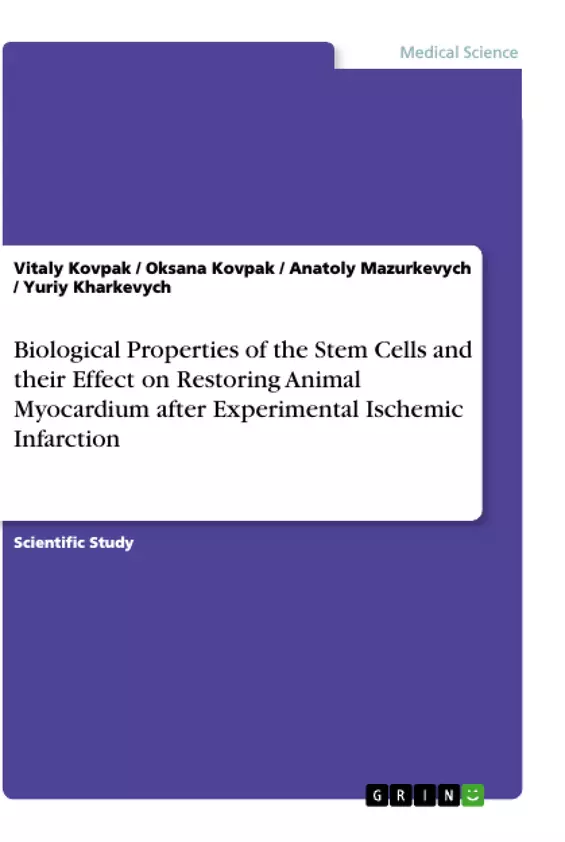The research mainly focuses on the culture of myocardium-derived stem cells as an alternative source of the cell materials for treating patients with heart disease.
Myocardial ischemia is a heart dysfunction caused by insufficient blood supply to its muscle tissue. This supply decrease can be related to the narrowing of coronary arteries, coronary thrombosis, or diffusive narrowing of arterioles and other small-sized vessels of the heart. Stopping the blood supply to the myocardium may lead to cardiac muscle necrosis (myocardial infarction).
Coronary arteries perfuse the heart and help transport the nutrients and Oxygen to metabolically active myocardium. Nowadays, myocardial ischemia, which is associated with atherosclerosis and coronary arteries obstruction, is the leading cause of death for both men and women, and according to the predictions it will remain so until 2030. Myocardial ischemia and myocardial infarction, which is associated with coronary arteries diseases, can also happen to small animals like cats and dogs, which may lead to a sudden death or death while under anesthesia.
Because the heart of adult mammals has extremely limited regeneration ability and the lost cells are replaced with fibrous scars, there is a need for search for treatment methods that are aimed at restoring the structure of cardiac muscle after the ischemia.
Cell technologies are a promising treatment method for animals with myocardial infarction that restores its structure and contractile function. In the past 50 years there have been a significant number of experimental researches that deal with the cell technologies issues. As a result of the research, we understand that stem cells and their derivatives may lay foundation for developing the innovative cell technologies, at any stage of histogenesis. The spectrum of clinical issues that this kind of treatment methods is expected to help with is astounding.
However, the introduction of cell technologies to the clinical practice requires a thorough guide for protocols on how to obtain the stem cells, cell culture and usage, deep study of recipient organism and the transplanted cells interaction, close control of phenotypic and genetic changes in order to provide high quality and safety of the used cell materials in restorative clinical therapy of post myocardial infarction changes in the myocardium.
Inhaltsverzeichnis (Table of Contents)
- Abstract
- Introduction
- Materials and research methods
- Preparation of stem cells from the rat's myocardium
- Preparation of stem cells from the red bone marrow of a rat
- Cytogenetic analysis of stem cells
- Micronuclear test
- Determination of proliferative activity of stem cells
- Cytotoxicity test
- Animal experiments
- Experimental myocardial infarction
- Transplantation of stem cells culture
- Morphological examination
- Preparation of stem cells from adipose tissue of a cat
- The influence of growth factors on the proliferative activity of stem cells
- Statistical data processing
- Research results
- Study of stem cells from the rat's myocardium
- Study of stem cells from the red bone marrow of a rat
- Study of the cat's stem cells
- CONCLUSION
- BIBLIOGRAPHICAL REFERENCES
Zielsetzung und Themenschwerpunkte (Objectives and Key Themes)
This monograph focuses on exploring the biological properties of stem cells and their effectiveness in restoring animal myocardium after experimental ischemic infarction. The research investigates the potential of stem cell transplantation as a therapeutic approach for cardiac repair in animal models.
- Characterization of stem cells derived from various sources, including rat myocardium, red bone marrow, and cat adipose tissue.
- Evaluation of the cytogenetic stability and proliferative activity of stem cells under different culture conditions.
- Assessment of the therapeutic efficacy of stem cell transplantation in restoring damaged myocardium in animal models.
- Analysis of the impact of growth factors on the proliferation and differentiation of stem cells.
- Exploration of the potential of stem cell therapy as a promising strategy for treating cardiovascular diseases in animals.
Zusammenfassung der Kapitel (Chapter Summaries)
The monograph begins with an introduction outlining the rationale and significance of the study, followed by a detailed description of the materials and research methods employed. The research results section presents findings on the biological properties of stem cells derived from different sources, including their cytogenetic stability, proliferative activity, and therapeutic potential. The study investigates the impact of growth factors on stem cell proliferation and examines the effectiveness of stem cell transplantation in restoring damaged myocardium in experimental animal models. The monograph concludes with a comprehensive discussion of the results and their implications for future research and potential applications in veterinary medicine.
Schlüsselwörter (Keywords)
The key focus of this monograph lies in exploring the biological properties of stem cells, specifically their role in restoring animal myocardium after experimental ischemic infarction. The research delves into the characterization of stem cells derived from various sources, their cytogenetic stability, proliferative activity, and therapeutic potential. The research utilizes a variety of methodologies including cytogenetic analysis, micronuclear test, cytotoxicity assays, and animal experimentation to investigate the effects of stem cell transplantation on cardiac repair. The study also investigates the influence of growth factors on stem cell proliferation and differentiation. The research findings contribute valuable insights into the potential applications of stem cell therapy in veterinary medicine, specifically for treating cardiovascular diseases in animals. These are the key themes, concepts, and research foci of the work, aiming to provide a comprehensive understanding of the role of stem cells in myocardial restoration.
- Arbeit zitieren
- Vitaly Kovpak (Autor:in), Oksana Kovpak (Autor:in), Anatoly Mazurkevych (Autor:in), Yuriy Kharkevych (Autor:in), 2021, Biological Properties of the Stem Cells and their Effect on Restoring Animal Myocardium after Experimental Ischemic Infarction, München, GRIN Verlag, https://www.grin.com/document/1043605



